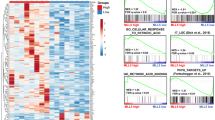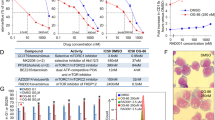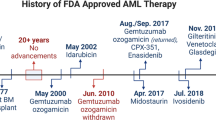Abstract
Acute myeloid leukemia (AML) is characterized by poor clinical outcomes due to high rates of relapse following standard-of-care induction chemotherapy. While many pathogenic drivers have been described in AML, our understanding of the molecular mechanisms mediating chemotherapy resistance remains poor. Therefore, we sought to identify resistance genes to induction therapy in AML and elucidated ALOX5 as a novel mediator of resistance to anthracycline-based therapy. ALOX5 is transcriptionally upregulated in AML patient blasts in comparison to normal hematopoietic stem/progenitor cells (HSPCs) and ALOX5 mRNA, and protein expression is increased in response to induction therapy. In vitro, and in vivo genetic, and pharmacologic perturbation studies confirm that ALOX5 positively regulates the leukemogenic potential of AML LSCs, and its loss does not significantly affect the function of normal HSPCs. ALOX5 mediates resistance to daunorubicin (DNR) and promotes AML cell survival and maintenance through its leukotriene (LT) synthetic capacity, specifically via modulating the synthesis of LTB4 and its binding to LTB receptor (BLTR). Our study reveals a previously unrecognized role of LTs in AML pathogenesis and chemoresistance, whereby inhibition of ALOX5 mediated LTB4 synthesis and function could be combined with standard chemotherapy, to enhance the overall therapeutic efficacy in AML.
This is a preview of subscription content, access via your institution
Access options
Subscribe to this journal
Receive 12 print issues and online access
$259.00 per year
only $21.58 per issue
Buy this article
- Purchase on Springer Link
- Instant access to full article PDF
Prices may be subject to local taxes which are calculated during checkout






Similar content being viewed by others
References
Renneville A, Roumier C, Biggio V, Nibourel O, Boissel N, Fenaux P, et al. Cooperating gene mutations in acute myeloid leukemia: a review of the literature. Leukemia. 2008;22:915–31.
Bonnet D, Dick JE. Human acute myeloid leukemia is organized as a hierarchy that originates from a primitive hematopoietic cell. Nat Med. 1997;3:730–7.
Shlush LI, Mitchell A, Heisler L, Abelson S, Ng SWK, Trotman-Grant A, et al. Tracing the origins of relapse in acute myeloid leukaemia to stem cells. Nature. 2017;547:104–8.
Pollyea DA, Jordan CT. Therapeutic targeting of acute myeloid leukemia stem cells. Blood. 2017;129:1627–35.
Kreitz J, Schonfeld C, Seibert M, Stolp V, Alshamleh I, Oellerich T, et al. Metabolic plasticity of acute myeloid leukemia. Cells. 2019;8:805.
Stefanko A, Thiede C, Ehninger G, Simons K, Grzybek M. Lipidomic approach for stratification of acute myeloid leukemia patients. PLoS ONE. 2017;12:e0168781.
Pabst T, Kortz L, Fiedler GM, Ceglarek U, Idle JR, Beyoglu D. The plasma lipidome in acute myeloid leukemia at diagnosis in relation to clinical disease features. BBA Clin. 2017;7:105–14.
Ye H, Adane B, Khan N, Sullivan T, Minhajuddin M, Gasparetto M, et al. Leukemic stem cells evade chemotherapy by metabolic adaptation to an adipose tissue niche. Cell Stem Cell. 2016;19:23–37.
Stuani L, Riols F, Millard P, Sabatier M, Batut A, Saland E, et al. Stable isotope labeling highlights enhanced fatty acid and lipid metabolism in human acute myeloid leukemia. Int J Mol Sci. 2018;19:3325.
Loew A, Kohnke T, Rehbeil E, Pietzner A, Weylandt KH. A role for lipid mediators in acute myeloid leukemia. Int J Mol Sci. 2019;20:2425.
Hanna VS, Hafez EAA. Synopsis of arachidonic acid metabolism: a review. J Adv Res. 2018;11:23–32.
Chen Y, Hu Y, Zhang H, Peng C, Li S. Loss of the Alox5 gene impairs leukemia stem cells and prevents chronic myeloid leukemia. Nat Genet. 2009;41:783–92.
Yektaei-Karin E, Zovko A, Nilsson A, Nasman-Glaser B, Kanter L, Radmark O, et al. Modulation of leukotriene signaling inhibiting cell growth in chronic myeloid leukemia. Leuk Lymphoma. 2017;58:1903–13.
Zovko A, Yektaei-Karin E, Salamon D, Nilsson A, Wallvik J, Stenke L. Montelukast, a cysteinyl leukotriene receptor antagonist, inhibits the growth of chronic myeloid leukemia cells through apoptosis. Oncol Rep. 2018;40:902–8.
Wan M, Tang X, Stsiapanava A, Haeggstrom JZ. Biosynthesis of leukotriene B4. Semin Immunol. 2017;33:3–15.
Tager AM, Luster AD. BLT1 and BLT2: the leukotriene B(4) receptors. Prostaglandins Leukot Ess Fat Acids. 2003;69:123–34.
Kanaoka Y, Boyce JA. Cysteinyl leukotrienes and their receptors: cellular distribution and function in immune and inflammatory responses. J Immunol. 2004;173:1503–10.
Austen KF. The cysteinyl leukotrienes: where do they come from? What are they? Where are they going? Nat Immunol. 2008;9:113–5.
Moore GY, Pidgeon GP. Cross-talk between cancer cells and the tumour microenvironment: the role of the 5-lipoxygenase pathway. Int J Mol Sci. 2017;18:236.
Haeggstrom JZ. Leukotriene biosynthetic enzymes as therapeutic targets. J Clin Investig. 2018;128:2680–90.
Massoumi R, Sjolander A. The role of leukotriene receptor signaling in inflammation and cancer. ScientificWorldJournal. 2007;7:1413–21.
Wang D, Dubois RN. Eicosanoids and cancer. Nat Rev Cancer. 2010;10:181–93.
Jala VR, Bodduluri SR, Satpathy SR, Chheda Z, Sharma RK, Haribabu B. The yin and yang of leukotriene B4 mediated inflammation in cancer. Semin Immunol. 2017;33:58–64.
Roos J, Oancea C, Heinssmann M, Khan D, Held H, Kahnt AS, et al. 5-Lipoxygenase is a candidate target for therapeutic management of stem cell-like cells in acute myeloid leukemia. Cancer Res. 2014;74:5244–55.
Rai KR, Holland JF, Glidewell OJ, Weinberg V, Brunner K, Obrecht JP, et al. Treatment of acute myelocytic leukemia: a study by cancer and leukemia group B. Blood. 1981;58:1203–12.
Prebet T, Bertoli S, Delaunay J, Pigneux A, Delabesse E, Mozziconacci MJ, et al. Anthracycline dose intensification improves molecular response and outcome of patients treated for core binding factor acute myeloid leukemia. Haematologica. 2014;99:e185–7.
Ishii S, Noguchi M, Miyano M, Matsumoto T, Noma M. Mutagenesis studies on the amino acid residues involved in the iron-binding and the activity of human 5-lipoxygenase. Biochem Biophys Res Commun. 1992;184:1133–4.
Nguyen T, Falgueyret JP, Abramovitz M, Riendeau D. Evaluation of the role of conserved His and Met residues among lipoxygenases by site-directed mutagenesis of recombinant human 5-lipoxygenase. J Biol Chem. 1991;266:22057–62.
Ziboh VA, Wong T, Wu MC, Yunis AA. Modulation of colony stimulating factor-induced murine myeloid colony formation by S-peptido-lipoxygenase products. Cancer Res. 1986;46:600–3.
Martin GH, Roy N, Chakraborty S, Desrichard A, Chung SS, Woolthuis CM, et al. CD97 is a critical regulator of acute myeloid leukemia stem cell function. J Exp Med. 2019;216:2362–77.
Hu Y, Smyth GK. ELDA: extreme limiting dilution analysis for comparing depleted and enriched populations in stem cell and other assays. J Immunol Methods. 2009;347:70–8.
Kikushige Y, Miyamoto T, Yuda J, Jabbarzadeh-Tabrizi S, Shima T, Takayanagi S, et al. A TIM-3/Gal-9 autocrine stimulatory loop drives self-renewal of human myeloid leukemia stem cells and leukemic progression. Cell Stem Cell. 2015;17:341–52.
Majeti R, Chao MP, Alizadeh AA, Pang WW, Jaiswal S, Gibbs KD Jr., et al. CD47 is an adverse prognostic factor and therapeutic antibody target on human acute myeloid leukemia stem cells. Cell. 2009;138:286–99.
Seita J, Sahoo D, Rossi DJ, Bhattacharya D, Serwold T, Inlay MA, et al. Gene expression commons: an open platform for absolute gene expression profiling. PLoS ONE. 2012;7:e40321.
Gentles AJ, Plevritis SK, Majeti R, Alizadeh AA. Association of a leukemic stem cell gene expression signature with clinical outcomes in acute myeloid leukemia. J Am Med Assoc. 2010;304:2706–15.
Bagger FO, Kinalis S, Rapin N. BloodSpot: a database of healthy and malignant haematopoiesis updated with purified and single cell mRNA sequencing profiles. Nucleic Acids Res. 2019;47:D881–5.
Chung SS, Eng WS, Hu W, Khalaj M, Garrett-Bakelman FE, Tavakkoli M, et al. CD99 is a therapeutic target on disease stem cells in myeloid malignancies. Sci Transl Med. 2017;9:eaaj2025.
Beerman I, Bhattacharya D, Zandi S, Sigvardsson M, Weissman IL, Bryder D, et al. Functionally distinct hematopoietic stem cells modulate hematopoietic lineage potential during aging by a mechanism of clonal expansion. Proc Natl Acad Sci USA. 2010;107:5465–70.
Chen XS, Sheller JR, Johnson EN, Funk CD. Role of leukotrienes revealed by targeted disruption of the 5-lipoxygenase gene. Nature. 1994;372:179–82.
Krivtsov AV, Twomey D, Feng Z, Stubbs MC, Wang Y, Faber J, et al. Transformation from committed progenitor to leukaemia stem cell initiated by MLL-AF9. Nature. 2006;442:818–22.
Zeisig BB, Fung TK, Zarowiecki M, Tsai CT, Luo H, Stanojevic B, et al. Functional reconstruction of human AML reveals stem cell origin and vulnerability of treatment-resistant MLL-rearranged leukemia. Sci Transl Med. 2021;13:eabc4822.
Evans JF. Cysteinyl leukotriene receptors. Prostaglandins Other Lipid Mediat. 2002;68-69:587–97.
Haribabu B, Verghese MW, Steeber DA, Sellars DD, Bock CB, Snyderman R. Targeted disruption of the leukotriene B(4) receptor in mice reveals its role in inflammation and platelet-activating factor-induced anaphylaxis. J Exp Med. 2000;192:433–8.
Sofia MJ, Floreancig P, Bach N, Baker SR, Nelson K, Sawyer JS, et al. The discovery of LY293111, a novel, potent and orally active leukotriene B4 receptor antagonist of the biphenylphenol class. Adv Exp Med Biol. 1997;400A:381–6.
Jones TR, Labelle M, Belley M, Champion E, Charette L, Evans J, et al. Pharmacology of montelukast sodium (Singulair), a potent and selective leukotriene D4 receptor antagonist. Can J Physiol Pharm. 1995;73:191–201.
Wunder F, Tinel H, Kast R, Geerts A, Becker EM, Kolkhof P, et al. Pharmacological characterization of the first potent and selective antagonist at the cysteinyl leukotriene 2 (CysLT(2)) receptor. Br J Pharm. 2010;160:399–409.
Stenke L, Samuelsson J, Palmblad J, Dabrowski L, Reizenstein P, Lindgren JA. Elevated white blood cell synthesis of leukotriene C4 in chronic myelogenous leukaemia but not in polycythaemia vera. Br J Haematol. 1990;74:257–63.
Hashidate T, Murakami N, Nakagawa M, Ichikawa M, Kurokawa M, Shimizu T, et al. AML1 enhances the expression of leukotriene B4 type-1 receptor in leukocytes. FASEB J. 2010;24:3500–10.
Stenke L, Sjolinder M, Miale TD, Lindgren JA. Novel enzymatic abnormalities in AML and CML in blast crisis: elevated leucocyte leukotriene C4 synthase activity paralleled by deficient leukotriene biosynthesis from endogenous substrate. Br J Haematol. 1998;101:728–36.
Runarsson G, Feltenmark S, Forsell PK, Sjoberg J, Bjorkholm M, Claesson HE. The expression of cytosolic phospholipase A2 and biosynthesis of leukotriene B4 in acute myeloid leukemia cells. Eur J Haematol. 2007;79:468–76.
Dittmann KH, Mayer C, Rodemann HP, Petrides PE, Denzlinger C. MK-886, a leukotriene biosynthesis inhibitor, induces antiproliferative effects and apoptosis in HL-60 cells. Leuk Res. 1998;22:49–53.
Khan MA, Hoffbrand AV, Mehta A, Wright F, Tahami F, Wickremasinghe RG. MK 886, an antagonist of leukotriene generation, inhibits DNA synthesis in a subset of acute myeloid leukaemia cells. Leuk Res. 1993;17:759–62.
Wang Y, Skibbe JR, Hu C, Dong L, Ferchen K, Su R, et al. ALOX5 exhibits anti-tumor and drug-sensitizing effects in MLL-rearranged leukemia. Sci Rep. 2017;7:1853.
Sawyer JS, Bach NJ, Baker SR, Baldwin RF, Borromeo PS, Cockerham SL, et al. Synthetic and structure/activity studies on acid-substituted 2-arylphenols: discovery of 2-[2-propyl-3-[3-[2-ethyl-4-(4-fluorophenyl)-5- hydroxyphenoxy]-propoxy]phenoxy]benzoic acid, a high-affinity leukotriene B4 receptor antagonist. J Med Chem. 1995;38:4411–32.
Tong WG, Ding XZ, Hennig R, Witt RC, Standop J, Pour PM, et al. Leukotriene B4 receptor antagonist LY293111 inhibits proliferation and induces apoptosis in human pancreatic cancer cells. Clin Cancer Res. 2002;8:3232–42.
Hennig R, Ding XZ, Tong WG, Witt RC, Jovanovic BD, Adrian TE. Effect of LY293111 in combination with gemcitabine in colonic cancer. Cancer Lett. 2004;210:41–6.
Schwartz GK, Weitzman A, O’Reilly E, Brail L, de Alwis DP, Cleverly A, et al. Phase I and pharmacokinetic study of LY293111, an orally bioavailable LTB4 receptor antagonist, in patients with advanced solid tumors. J Clin Oncol. 2005;23:5365–73.
Pian P, Labovitz E, Hoffman K, Clavijo CF, Rzasa Lynn R, Galinkin JL, et al. Quantification of the 5-lipoxygenase inhibitor zileuton in human plasma using high performance liquid chromatography-tandem mass spectrometry. J Chromatogr B Anal Technol Biomed Life Sci. 2013;937:79–83.
Zhou GX, Ding XL, Wu SB, Zhang HF, Cao W, Qu LS, et al. Inhibition of 5-lipoxygenase triggers apoptosis in pancreatic cancer cells. Oncol Rep. 2015;33:661–8.
Winer ES, Stone RM. Novel therapy in acute myeloid leukemia (AML): moving toward targeted approaches. Ther Adv Hematol. 2019;10:2040620719860645.
Acknowledgements
The authors thank Drs. Neil Rosen and Ross L. Levine for scientific discussions and Memorial Sloan Kettering Cancer Center for use of its Shared Services (Flow Cytometry Core, Integrated Genomics Operation, and Molecular Cytology Core).
Funding
This work was supported by the National Institutes of Health grant 5T32GM008539 for pre-doctoral training in Molecular Biology, the National Center for Advancing Translational Sciences (NCATS) grant TL1TR000459 of the Clinical and Translational Science Center at Weill Cornell Medical College (AWS), and the National Cancer Center (NCC) Postdoctoral Fellowship (Award ID AWD00005314) (SC). This work was also supported by the NIH/NCI (5 R01 CA164120-03), and the Leukemia and Lymphoma Society Scholar Award Program (CYP).
Author information
Authors and Affiliations
Contributions
Contribution: AWS, FF, IB, and CYP conceived and designed the study; AWS and MK acquired the mouse data; AWS and CYP analyzed and interpreted the mouse data; IB and SC carried out BLTR related experiments and analysis; SC performed the formal analysis of the transcriptomic data; IB performed and analyzed the experiments involving primary AML specimens; AWS, IB, and CYP wrote, reviewed, and/or revised the manuscript; MK provided technical or material support; and CYP supervised the study.
Corresponding author
Ethics declarations
Competing interests
The authors declare no competing interests.
Additional information
Publisher’s note Springer Nature remains neutral with regard to jurisdictional claims in published maps and institutional affiliations.
Supplementary information
Rights and permissions
About this article
Cite this article
Stranahan, A.W., Berezniuk, I., Chakraborty, S. et al. Leukotrienes promote stem cell self-renewal and chemoresistance in acute myeloid leukemia. Leukemia 36, 1575–1584 (2022). https://doi.org/10.1038/s41375-022-01579-0
Received:
Revised:
Accepted:
Published:
Issue Date:
DOI: https://doi.org/10.1038/s41375-022-01579-0



